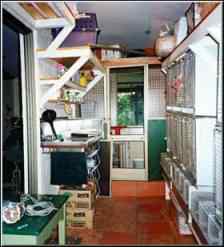
Tolga Bat Hospital is very busy October to December each year when hundreds of Spectacled flying foxes are affected by tick paralysis. Throughout the rest of the year the bats come in mainly with injuries from being caught on barbed wire, to a lesser extent electric shock from powerlines and other trauma. We have a very smart air conditioned hospital with 20 individual hanging cages,16 lying cages, an indoor 2 metre by 1 metre cage. The 8 metre outdoor cage will soon be superseded by a 12 metre hexagonal flight cage. The hospital itself is rarely used outside of tick season. Injured bats may spend a night in there but move to the outside cage as soon as possible. They are colony animals and do not like to be alone. It can get quite cold in winter in the outside cage. We have 2 infrared heaters, one 800 watt and one 2400 watt. The bats really enjoy the heat and huddle around them. Start a tree planting program today - save the life of a flying fox! 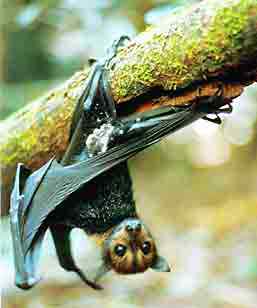 ORPHANS We get up to 250 babies through the hospital each tick season, many of them orphans. We are able to reunite some with their mothers. This is usually an arduous process. By the time the mother has recovered from tick paralysis, her milk has often dried up. With the baby on her, it will usually take about 4 days for her to be lactating again. ORPHANS We get up to 250 babies through the hospital each tick season, many of them orphans. We are able to reunite some with their mothers. This is usually an arduous process. By the time the mother has recovered from tick paralysis, her milk has often dried up. With the baby on her, it will usually take about 4 days for her to be lactating again.
However in this time we usually need to remove the baby for regular feeds, although some mothers will let you feed the baby while still on the mothers. Once the milk supply is re-established, the baby needs to be removed daily for weighing to check there is enough milk ; then even when the weight gain looks good, it is still wise to continue weighing the baby every week.
We foster out as many orphans as possible but are usually left with about 100 babies at the hospital itself. The fostered babies return to us around New Year for creching and release.
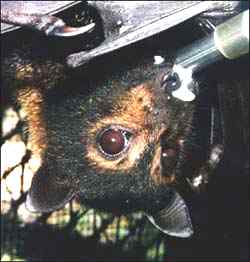
These babies have the following experiences:
- Baby cannot feed normally as mum is unwell. Mum usually falls to the ground with baby still attached, although the older baby, 5 weeks and over, is often separated. Babies over the age of 8 weeks often remain up in the canopy and pole rescues are necessary, if possible. Many of these older babies will only come to the ground after they are dead. It is very sad to hear them crying out for their mother, who is by now dead from tick paralysis or in the hospital. Many of them are hoarse or lose their voices temporarily after rescue.
- Baby is often rescued with maggot eggs and these must be combed out. It is important to re-check these babies for more eggs over the next few days. Some are rescued with live maggots, particularly in the eyes or under the wings. These are sprayed with a mild pyrethrin spray and put on antibiotics. Unfortunately some need to be euthanased.
- Baby is often dehydrated and needs fluid replacement. This can usually be achieved orally but sometimes with injections into the peritoneum or subcutaneously.
- Baby is weighed and the forearm measured.
- Baby is fed human infant formula 2-4 hourly depending on age and condition. We use Heinz Follow-On for human infants over 6 months as it has a higher protein content than formula for infants 0-6 months. A botttle and teat is used. If baby is young or a poor feeder we use a syringe to drip the milk into the teat. This allows a lot of control over the flow of milk. Some poor feeders tolerate human soy infant formula better.
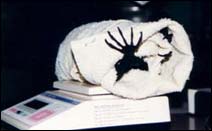 - Fruit is introduced at about 8 weeks but milk continued as well. Begin with softer fruits like papaw, banana and rockmelon. By now our babies are drinking milk from self-feeders and are in the outside cage. Whole apples are hung on S-hooks, initially with wedges cut out so they can bite into it more easily. This encourages work / play for their food.
- For the last 4 years we have let the orphans free from the bat hospital. They climb into the trees over the cage at night and learn to fly. They return to the cage in the morning. However we are having increasing problems with predators - owls (barking and rufous), pythons and dingos. With the construction of the new flight cage we will be able to keep the orphans inside until we take them to the release cage at the colony.

About 10 bats at a time are taken to the release cage. This is a large dog crate winched up into the canopy. Orphans are kept in for 3 days. The cage is winched down each day to put food in. After 3 days these bats are put outside and another 10 bats are put inside. This process is repeated as many times as necessary to bring all the orphans out to the colony. We believe the presence of the orphans inside the cage encourages the outside orphans to return - as well as the presence of food. The release cage is in a section of the colony used by many mothers with babies. Our orphans can fly out with their wild peers, learning with them about bush tucker and gaining strength and endurance in flight. It is vital they integrate into the social structure of the colony. - Daily feeding is continued for at least a month after the last orphans are put outside. The food is then reduced. They are fed less frequently as well as a lesser amount. Often in June we will still go out once a week and have 30 or so bats come down to the cage when it is winched back up.
ADULTS IN PERMANENT CARE
We have relevant permits from Queensland National Parks and Wildlife to keep a small number of adults that are too injured to return to the wild. Most of these bats cannot fly due to loss of wing membrane and nerve injuries. Important aspects of their care include - Lots of sunshine. Flying foxes love to be in the full sun, fanning themsleves to keep cool. Occasional very high temperatures over 40degrees centigrade can be fatal though - there have been occasions 1500kms to the south where Black and Grey-headed flying foxes have died in large numbers.
- Varied fruit with apple being the mainstay. When feeding large numbers of bats it is very hard to get bush food for them. We hang as much fruit as possible on S-hooks, rather than chop.
- Protein source. We use full cream milk powder as our protein source. We make it into a banana smoothie with honey and water.
- Blossom from the Myrtacae family is an important part of the megabat diet in the wild, both for the nectar and pollen. The Little Reds are almost exclusively blossom feeders. Melaleuca leucadendron is a big favourite.
- Leaf browse. There are several species of plants which are very popular with fruit bats for leaf fractionation. It is believed that the leaves are a source of vitamin E and protein. Lubee Foundation in Florida USA have found Vit E deficiency in their bats and now have kale regularly in the diet. The popular species we have found for Spec
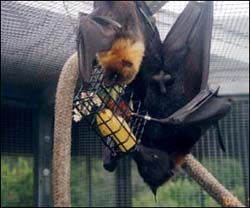 tacleds are mulberry, fiddlewood (Citharexylum quadrangulare) and Avicennia mangrove. tacleds are mulberry, fiddlewood (Citharexylum quadrangulare) and Avicennia mangrove. - Bats for company. These very sociable intelligent animals need their own kind.
- Opportunities for mental stimulus. Flying foxes get bored in captivity. Dana le Blanc at Lubee has done a lot of work on enrichment for megabats at Lubee. Whole apples on an S-hook for example are better than cut apple in a container as they need to 'work' for it. Bat 'toys' at Amanda Lollar's Batworld in Texas USA are found strewn all over the floor in the mornings. Finding the nectar in blossom is another great activity.
- Opportunities for physical fitness activities Bats that cannot fly need to be motivated to climb and move. Until recently our bats have always lived outside the cage and so spent the night out in the trees. Predator problems have forced a re-think of this. We would like to afford building an enclosure that included several trees.
CLEFT PALATE SYNDROME
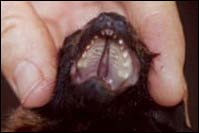 Each year we get about 1 or 2 abandoned babies with cleft palate syndrome. The syndrome includes a large midline defect that extends to the throat, missing or rudimentary thumb and toe claws, general low muscle tone and whiskery faces. The young present their mothers with difficulties in feeding as well as hanging on. Most are abandoned shortly after birth and so still have the cord attached, some even have the placenta. A few are found at 2-3 weeks of age, undernourished yet alive. These babies with the severe defect must all be euthanased as they cannot survive. Each year we get about 1 or 2 abandoned babies with cleft palate syndrome. The syndrome includes a large midline defect that extends to the throat, missing or rudimentary thumb and toe claws, general low muscle tone and whiskery faces. The young present their mothers with difficulties in feeding as well as hanging on. Most are abandoned shortly after birth and so still have the cord attached, some even have the placenta. A few are found at 2-3 weeks of age, undernourished yet alive. These babies with the severe defect must all be euthanased as they cannot survive.
Occasionally we find babies with only a pin hole cleft , but they still have the other aspects of the syndrome. Sophie and Paula are 2 such bats. Sophie was born in 1998 and Paula in 2001. These were the years that unexplaine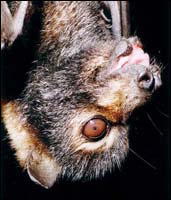 d large numbers of babies were born with this syndrome. Research is only just beginning. d large numbers of babies were born with this syndrome. Research is only just beginning. Sophie is always the first bat out of the cage in the morning. She likes to hang where there is netting to catch her should she fall. She has been described as a 'camera moll' by an ABS film crew and 'a flirt' by others. She likes to hang from the bottom of loose netting and flap as fast as she can until she starts swinging. She cannot fly more than 20 metres. She lives independently with all the other bats keeping herself well-groomed. Note her craniofacial anomolies. In her first 2 years she had 2 sinus infections that settled very quickly with oral amoxycillin. At this time she also had difficulties hanging, falling quite often - in doing so removing a few protuberant teeth. The split you can see in her bottom lip is a reminder of all those falls. 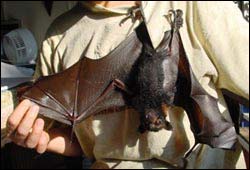 Paula has a lot more difficulties hanging. We have a horizontal net in the cage to catch her when she falls. She rests in a sling most of the day but hangs most of the night. Her hanging does not appear to be improving as Sophie's did. Indeed as she is getting heavier it appears to be getting worse. Paula has a lot more difficulties hanging. We have a horizontal net in the cage to catch her when she falls. She rests in a sling most of the day but hangs most of the night. Her hanging does not appear to be improving as Sophie's did. Indeed as she is getting heavier it appears to be getting worse.
We trialled some artificial nail extensions. A dental technician used a composite resin as used in teeth fillings, making her claws longer and more curved. For the first 24 hours it was a miracle. Paula could move around like never before. Then she climbed up some small mesh (1cm by 1cm) and broke them off. We will redo the nails when the mesh has been replaced - end August 2002.
Compared with Sophie, Paula's craniofacial structure is relatively normal. However she has the same orthodontic problems. Directions: Booking for tours is essential.
Phone: 07 4091 2683
email: jenny.maclean@iig.com.au Follow your maps to Atherton, They are not at Tolga. (The colony of Spectacled flying foxes they mainly work with live at Tolga !)
Drive out the main street of Atherton on the road to Herberton for 6 kms and turn right into Carrington Road.
Follow for 1 km to the end of the bitumen and then take the first driveway on the right after Hutton Road, about 100 metres from the end of the bitumen. There are 2 signs, Pteropus House and Land for Wildlife. Once in the driveway take the left turn and follow it to The Bat Hospital.
Return to Bat Page | 